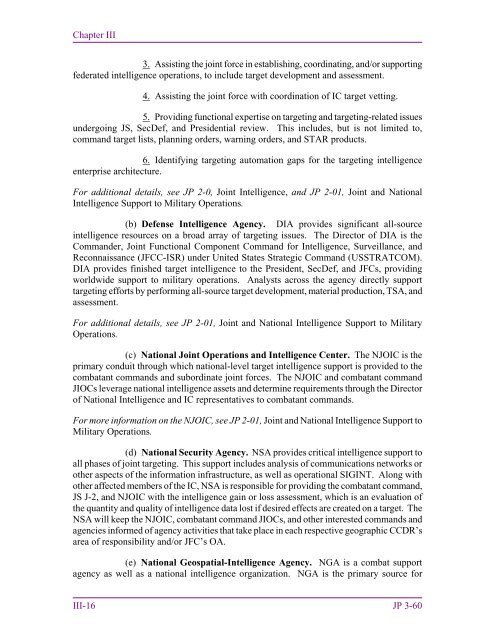Joint Targeting
1F87id9
1F87id9
Create successful ePaper yourself
Turn your PDF publications into a flip-book with our unique Google optimized e-Paper software.
Chapter III<br />
3. Assisting the joint force in establishing, coordinating, and/or supporting<br />
federated intelligence operations, to include target development and assessment.<br />
4. Assisting the joint force with coordination of IC target vetting.<br />
5. Providing functional expertise on targeting and targeting-related issues<br />
undergoing JS, SecDef, and Presidential review. This includes, but is not limited to,<br />
command target lists, planning orders, warning orders, and STAR products.<br />
6. Identifying targeting automation gaps for the targeting intelligence<br />
enterprise architecture.<br />
For additional details, see JP 2-0, <strong>Joint</strong> Intelligence, and JP 2-01, <strong>Joint</strong> and National<br />
Intelligence Support to Military Operations.<br />
(b) Defense Intelligence Agency. DIA provides significant all-source<br />
intelligence resources on a broad array of targeting issues. The Director of DIA is the<br />
Commander, <strong>Joint</strong> Functional Component Command for Intelligence, Surveillance, and<br />
Reconnaissance (JFCC-ISR) under United States Strategic Command (USSTRATCOM).<br />
DIA provides finished target intelligence to the President, SecDef, and JFCs, providing<br />
worldwide support to military operations. Analysts across the agency directly support<br />
targeting efforts by performing all-source target development, material production, TSA, and<br />
assessment.<br />
For additional details, see JP 2-01, <strong>Joint</strong> and National Intelligence Support to Military<br />
Operations.<br />
(c) National <strong>Joint</strong> Operations and Intelligence Center. The NJOIC is the<br />
primary conduit through which national-level target intelligence support is provided to the<br />
combatant commands and subordinate joint forces. The NJOIC and combatant command<br />
JIOCs leverage national intelligence assets and determine requirements through the Director<br />
of National Intelligence and IC representatives to combatant commands.<br />
For more information on the NJOIC, see JP 2-01, <strong>Joint</strong> and National Intelligence Support to<br />
Military Operations.<br />
(d) National Security Agency. NSA provides critical intelligence support to<br />
all phases of joint targeting. This support includes analysis of communications networks or<br />
other aspects of the information infrastructure, as well as operational SIGINT. Along with<br />
other affected members of the IC, NSA is responsible for providing the combatant command,<br />
JS J-2, and NJOIC with the intelligence gain or loss assessment, which is an evaluation of<br />
the quantity and quality of intelligence data lost if desired effects are created on a target. The<br />
NSA will keep the NJOIC, combatant command JIOCs, and other interested commands and<br />
agencies informed of agency activities that take place in each respective geographic CCDR’s<br />
area of responsibility and/or JFC’s OA.<br />
(e) National Geospatial-Intelligence Agency. NGA is a combat support<br />
agency as well as a national intelligence organization. NGA is the primary source for<br />
III-16 JP 3-60


